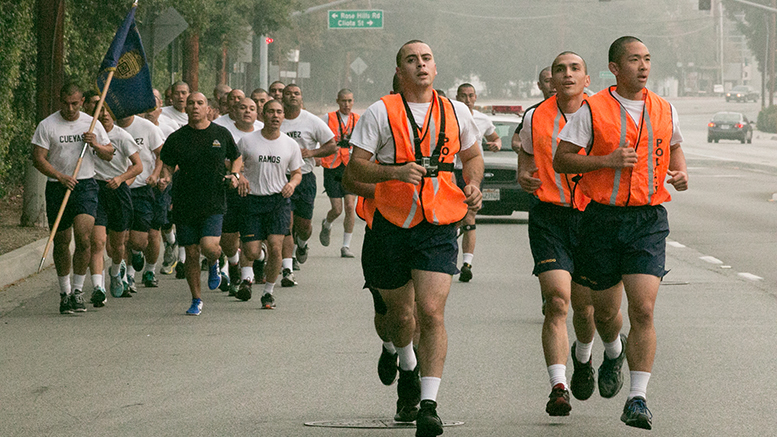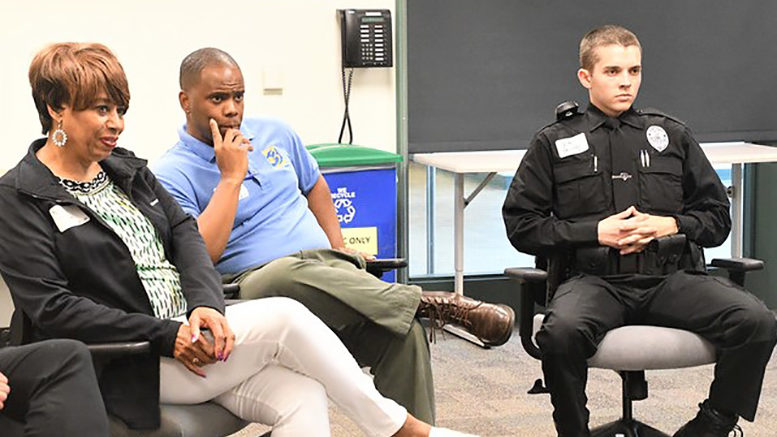Cadets at the Kalamazoo Valley Community College Police Academy in Michigan watched the video of George Floyd in his final moments struggling to breathe under the knee of a Minneapolis police officer.
“I told them, ‘if you all don’t see anything wrong with that, don’t come back tomorrow,’” said Victor Ledbettor, director of the college’s Law Enforcement Training Center.
Everybody came back. But their training and careers will be altered by Floyd’s death and the outpouring of public fury over police tactics, shootings and abuse of citizens.
“I think we’re moving to a new direction,” Ledbetter said. “The world is changing and the police are going to have to change with it.”
A new direction
As a black man with a long career in law enforcement, Ledbetter welcomes the moment. Since becoming director of the community college’s police academy in 2018, he’s continually devised ways to build understanding and empathy among police officers and minority citizens.
“People are seeing what we as people of color have been talking about for centuries when it comes to police relations,” Ledbetter said. “George Floyd changed things. People saw a man die, begging for his life, and that has affected people.”
Educators reacted swiftly after Floyd’s death. Community college leaders in California, Virginia and Minnesota sought reviews of instruction at campus police academies. The North Carolina Community Colleges system freed up funding for more training in community policing.
“We need to ensure that our curriculum reflects the views and backgrounds of the people that we serve in our communities,” Eloy Ortiz Oakley, chancellor of California’s 115 community colleges, said in an interview with EdSource.
A hub for police training
Starting in the 1970s, when most states began setting standards for police training and sometimes requiring that recruits earn college credits, many law enforcement agencies have looked to community colleges to train their officers.
“There is no better place to train people in public safety than community colleges,” said Clayton Harris, police chief and dean of public safety at Cuyahoga Community College (Tri-C) in Cleveland. “We are set up to assist and help the workforce, and we grow our training around the culture of a community.”
While the share of police officers educated at community colleges varies among states, in California it’s around 80 percent.
The basics of law enforcement training are decided by Peace Officers Standards and Training (POST) commissions in each state. Among other things, they determine the minimum hours of training required and a mandatory curriculum. But academies usually have the discretion to augment state requirements.

California’s POST commission requires a minimum 664 hours of curriculum. The Rio Hondo College Police Academy in Whittier, California, builds an additional 314 hours into each session, said Walter Allen, director of the academy. Many of those hours are spent on cultural awareness and community policing.
Allen invites people of color and members of religious minorities to visit the academy and speak with students about discrimination they’ve experienced.
“We want to ensure that when our cadets leave here they’re not warriors but guardians,” he said.
In Kalamazoo, Ledbetter’s cadets spend a “culture week” learning about ethics, civil rights, adverse childhood experiences, implicit bias and cultural awareness. On the final day, the mostly white cadets spend time with black and other minority members of the community in facilitated “racial healing circles.”
“It helps the police realize that all black people and people of color aren’t criminals. And it helps the community realize that all police officers aren’t bad,” Ledbetter said. “Once you start breaking down these barriers and put people in a place where you can talk, I’m telling you, it’s fantastic.”
The importance of field training
But academy directors understand they must prepare future police officers for what is arguably the most adversarial environment in a generation.
Ken Sissom, director of the Johnson County Community College Regional Police Academy in the Kansas City suburbs, said he met recently with worried police chiefs in his relatively affluent county.
“We don’t have the problems they have in many of the areas,” Sissom said. “But it’s not easy to hire police officers. This environment makes it worse.”
To improve policing, communities should look not only at what is taught inside police academies, but what happens after that, directors said.
Academy graduates are assigned to field officers in their new departments, who guide them through their first months on the job. Better coordination among academies and training officers would help cement some of the principles taught in academies, directors said.
“The field training officer is a crucial part of the puzzle,” Allen said. “If the training officer says, ‘forget everything you learned in the academy,’ that’s problematic.”
It’s also problematic when concepts such as bias-free policing and de-escalation are cast aside as an officer’s career progresses.
“It’s been shown over and over that people respond when police are part of their communities, when you treat everybody fairly, when you only use the force that is necessary and not beyond,” said Harris, who served in the Cleveland and East Cleveland police departments before becoming police chief of Tri-C’s multi-campus system.
“You’ve got to teach this stuff repetitively, and you’ve got to do it in an environment that is free of harm and risk. We don’t do that on so many levels.”
Since Floyd’s death, the Cuyahoga County Sheriff’s Department has asked the community college to prepare training modules for veteran deputies, Harris said.
Holding each other accountable
Because of Floyd’s death, for which four Minneapolis police officers face murder charges, academies probably will spend more time educating recruits on their duty to intervene if they see a fellow officer abusing a citizen, directors said.
But empowering officers to intervene and report suspected misconduct will also require changes beyond the academy, Harris said.
“How do we make it so that when someone reports an incident they aren’t victimized for doing so?” he said. “Patrol officers feel sometimes like they’re working for the union, and not the community and the department. You don’t learn that in the academy. That’s something you get from the job, and who you think has your back.”
Because policing is an essential service, many community college police academies remained open through the COVID-19 shutdowns. Cadets and instructors have had ample opportunity to process Floyd’s death and what it might mean for the profession.
“It sickens me that the incident gave all of law enforcement a black eye, which it does not deserve,” said Allen at Rio Hondo College.
But Allen, who has spent more than 40 years in law enforcement and corrections, has seen upheavals before.
“This too will right itself and good will come out of this,” he said. “Has there been profiling against minorities? Yes. Has it gotten any better? Yes, it has. Can it get any better than what it is now? Of course it can. Where it starts is in the police academy.”

